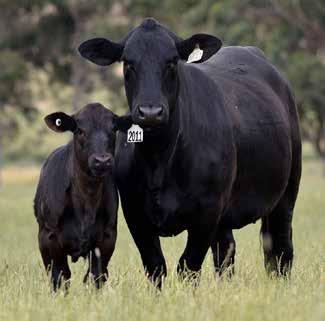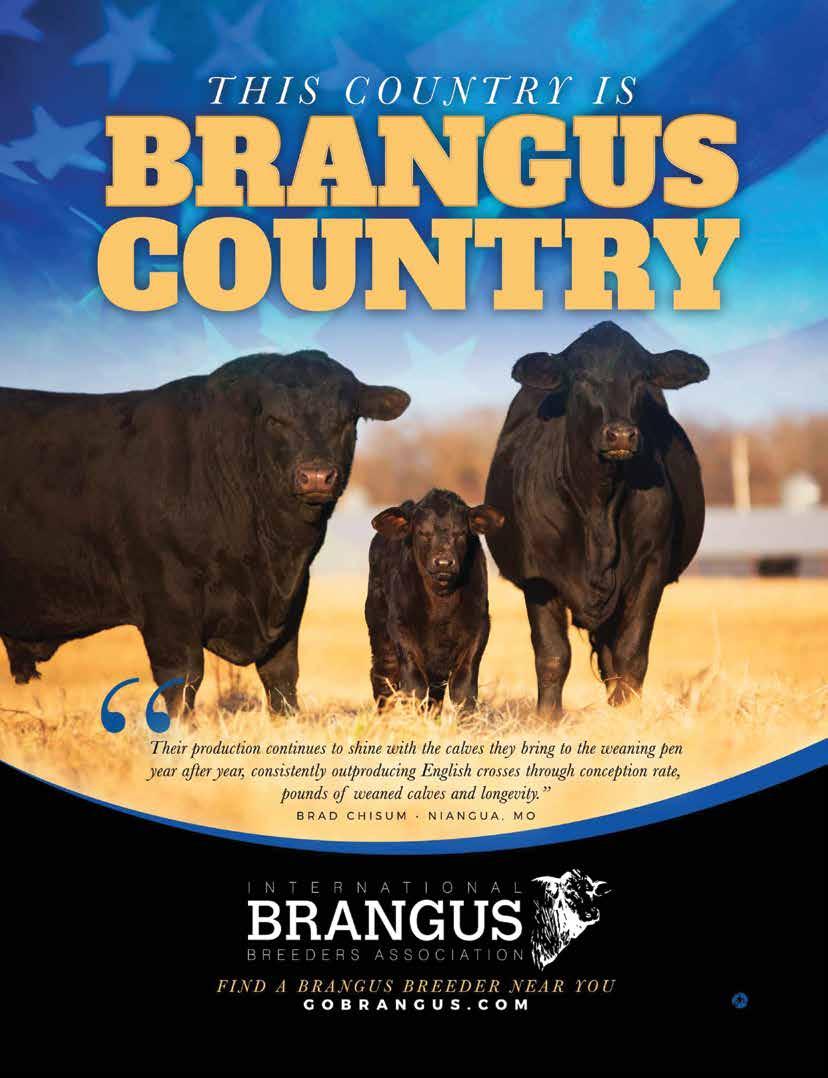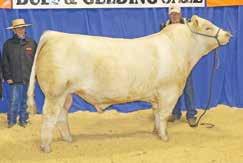
8 minute read
Genetic views from Brangus
by International Brangus Breeders’ Executive Vice President Darrell Wilkes, Ph.D.
34 California Cattleman March 2020 I t seems apparent that the primary opportunity to continue improvements in beef production efficiency and carcass value will come from genetic advancement. This may not surprise anybody. What might surprise you is to learn that experts in poultry production believe that 90 percent of their future gains in productivity will come form genetics also. Poultry scientists round out the remaining 10 percent of potential gains under the categories of nutrition at five percent; environment at three percent; and health at two percent. This is a bit surprising to me. I had been led to believe that the poultry industry already had their ducks in a row regarding genetics (attempt at poultry humor intentional). I vividly recall my days in graduate school sharing a large basement office with other graduate students who were working on pig genetics. They spoke with excitement and anticipation that someday, maybe sometime, pigs would convert feed at 4-to-1 and would wean eight pigs per litter. “Wow,” they said, “Such gains would be incredible.” Well, they underestimated their own science. Professional breeding companies and high tech integrators came into play in the pig industry and they now convert feed at 2.2-to-1 and wean over 11 pigs per litter. A leading pig genetics company claims they are currently achieving a faster rate of genetic improvement than ever before in their history. After all, the gains they’ve made, one would think that their rate of improvement would be hitting a plateau. The opposite is true. Beef production has also had dramatic increases in productivity. Compared to just 30 years ago, we are producing about 25 percent more beef with about 10 percent fewer beef cows. The total cattle inventory has shrunk from about 130 million in 1976 to less than 95 million in 2019 while beef production has increased by 20 percent. This advancement is pretty easy to explain. In simple terms, we have produced faster-growing cattle that reach a heavier finish weight sooner. This has come about through advancements in genetics, nutrition and health – significant changes in business models which encouraged cattle placement into feedlots at a younger age. Instead of placing 18-month-old cattle in a feedlot, the industry is sending 18-month (or younger) cattle to the packer weighing 1,300 to 1,400 pounds. The total savings in feed alone is almost impossible to calculate. If the beef industry is going to continue this trend in productivity gains, I submit that most of it must come from genetics. Gains from nutrition, management and health will continue, of course. One could argue, however, that the trend to place younger cattle into feedlots might not have much room for growth moving forward. Our genetic improvement curve should get steeper in the years ahead compared to the curve we’ve seen in the past 30 years. Today, when we add the benefits of massive databases with ultra-powerful computers along with the power of genomics (DNA testing), we can buy a virgin bull with the same degree of genetic assurance that once required 20-30 progeny records to create. With higher fertility semen and very effective synchronization protocols, seedstock breeders who utilize artificial insemination (AI) can stack pedigrees and produce extraordinary genetic packages by the thousands. I was amazed to discover that nearly 10 percent of the Brangus registrations come from embryo transfer; which means that breeders are not only skimming off the very top of the sire pool to make the next generation, they are also cherry-picking the cows. We have the tools to producer beef more efficiently while not compromising quality. According to recent reports by USDA’s Economic Research Service, beef steak, on average, sells for about double the price of a pork chop and about triple the price of a chicken breast. This concerns some folks. I personally think it’s great. Consumers have a choice. Nobody is forcing them to choose beef when they could dine cheaper on pork or poultry. They are willing to pay more for beef because it’s worth it to them. I learned that in Econ 1010. While we strive to continue the gains in productivity, we need to remember the premium that consumers willingly pay for beef comes with an expectation that it tastes great. Now, back to genetics. With the extraordinary tools we have available today, we can actually improve the quality of beef simultaneously with improving production efficiency. For decades, it was postulated that beef quality and production efficiency were antagonistic. That isn’t true. With modern genetic evaluation tools, we can identify animals that excel in both – quality and efficiency. Brangus breeders are committed to offering the very best genetics available to produce high quality beef in harsh environments. Your investment in registered Brangus genetics is one of the highest return in investments you can make. Visit www.GoBrangus.com to find a Brangus breeder near you. Invest in Brangus genetics. The payback is there.

As the ink dries and the book closes on the movement known as Brexit, questions arise as to what is next in terms of trade for a European giant—and how that could impact U.S. cattle producers.
While Britain’s exit from the European Union (EU) was finalized late last month, what that truly signifies is the beginning of a transition period that will last throughout 2020. While under agreed upon terms, Britain will operate under EU rules until the end of 2020, by leaving the EU the country is free to strike out trade deals on its own, now unbeholden to EU guidelines affordable and high-quality beef products such as what the U.S. produces. The U.K. only produces about 60 percent of the food that it consumes, leaving a large opportunity. This is an untapped market with high potential, and if this administration’s history of willingness to strike trade deals in favor of the U.S. beef cattle industry is any indication, Brexit is just another opportunity to get more American beef on plates across the world.
CCA staff will continue to monitor the situation and keep you updated as negotiations develop.
and regulations. While throughout the rest of the year it will be business as usual in terms of trade, this historic exit offers a unique opportunity for agriculture in the United States.
For decades, British trade has been bound by restrictive guidelines, negotiated by a large bureaucratic system in Brussels and heavily influenced by other European nations. While if the duration of the Brexit movement itself is any indicator, negotiations between the United Kingdom (U.K.) and the EU could drag into 2021, the U.S. government has been clear that solidifying a bilaterally beneficial trade deal with the U.K. as soon as possible is of the highest priority.
But what does that mean for U.S. beef? For years there have been longstanding, non-science-based barriers to trade with the European market. Especially at a time when some British agriculture interests are understandably protective in their views of foreign trade, the battle may be somewhat uphill. The British media and even some farm groups have teamed up with environmental activist groups in an effort to disparage other countries’ agriculture on issues ranging from environmental footprint to animal welfare practices. While the details have yet to be worked out, The U.K.’s Secretary of State for Environment, Food and Rural Affairs, Theresa Villiers has already ruled out ending the EU’s current ban on chlorinated chicken and hormone-treated beef. But, also for decades British consumers have not had access to
looKing for the best the West has to offeR
5th Annual
THD ©
Temale Sale l
may 9 modesto Jr. College ag pavilion Modesto, California saturday

>> bred & open fall & spring heifers >> fall bred cows & spring pairs >> donors, embryos, pregnancies & more Deadline to Enter: March l5 th
auctioneer: rick machado 805.501.3210 sale manager matt macfarLane 916.803.3113 cell m3cattlemarketing@gmail.com www.m3cattlemarketing.com
Watch & Bid Live wsaa sale c0mmittee Brad cox..................541.840.5797 david hoLden...........530.736.0727 jim vietheer............916.834.2669 graham hooper.......208.539.1712

sponsored by the
follow us on
Join Us on Our New Date at the 2 nd Saturday in May a portion of the sale proceeds will benefit the wnaf in reno, nevada THD ©
CARDEY RANCHES A champion source for more than 60 years
2020 Red Bluff Reserve Supreme & Champion Charolais Bull Purchased by Gary Silva, Galt

THANK YOU TO OUR 2020 RED BLUFF & KLAMATH BULL SALE BUYERS!
GARY SILVA, GALT CABRAL LIVESTOCK, RIO VISTA, CA ADAMS 4S. COTTONWOOD, CA DUSTY DEBRAGA, RED BLUFF, CA B BAR K CASCADE RANCH, EAGLE POINT, OR NATHAN OWENS, RED BLUFF CA 3-J LIVESOCK, PALO CEDRO, CA



POWERS RANCH, MYRTLE POINT, OR
JIM COCKRELL LAKE CITY, CA
DANIEL VENTURACCI, FALLON, NV
CLINTON HALL, TULELAKE, CA
SCOTT HAYDENMEYER, OAKDALE, CA
IRA RENNER, JIGGS, NV
2020 Red Bluff Champion Shorthorn Bull Purchased by Gary Silva, Galt

CARDEY RANCHES Don & Diana Cardey • Turlock, CA (209) 634-5491 • (209) 634-1857 Honored to be selected as 2020 Red Bluff Co-Consignor of the Year!
LOOKING FOR RANCH LAND SEEKING +-2000 ACRES BETWEEN SANTA BARBARA & SAN LUIS OBISPO


Contact Jim Gibson jfgibson70@gmail.com 530-228-8385
Petersen & ComPany agricultural real estate
400± acres of range land for sale along Highway 26 in Valley Springs. Three parcels, including a buildable residential lot. There is a reservoir that has water year round, and two windmills. Land is currently fenced for cattle. 2,880± sq. ft. shop offers plenty of storage for your tractors or feed.
Located in the heart of the North Delta, just west of Sacramento in Yolo County. These 3 parcels offer many possibilities. Cheap water and great potential to grow your own feed. Currently planted to alfalfa, or convert to irrigated pasture. 60.39± to 387.29± acres available.
Centrally located between the foothills and Highway 99. 2,900± sq. ft. custom home with a 3,700± sq. ft. shop, plus 1,700± sq. ft. of covered parking area. Duck Creek runs through the property and feeds the ag pump for irrigation. 15± acres of fully fenced irrigated pasture.










